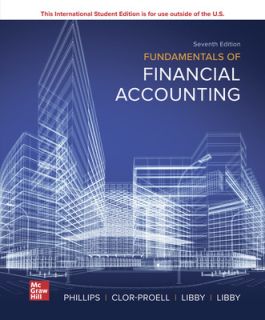Fundamentals of Financial Accounting ISE
7th Edición
1264364385
·
9781264364381
© 2022 | Published: January 5, 2021
Fundamentals of Financial Accounting introduces students to financial accounting using a balanced mix of conversational wording, clear and concise presentations, and everyday examples, allowing students to grasp concepts fundamental to financial acco…
Leer Más
Gracias este es un libro electrónico o EBOOK, para poder utilizarlo debes de crear una cuenta en VitalSource Bookshelf esta es una Aplicación Gratis. Una vez que has creado tu cuenta, dentro de la plataforma debes de redimir los distintos códigos que hayas adquirido para poder leer tus libros.
Para pagos en BBVA, transferencias interbancarias o tiendas de autoservicio, NO REDONDEAR el monto.
- Ingresa a tu libro desde cualquier lugar o dispositivo, con acceso a internet o sin acceso.
- Crear notas, y apuntes en tus lecturas.
- Puedes realizar búsquedas a los conceptos que necesites de manera rápida y fácil.
Chapter 1: Business Decisions and Financial Accounting
Chapter 2: The Balance Sheet
Chapter 3: The Income Statement
Chapter 4: Adjustments, Financial Statements, And Financial Results
Chapter 5: Fraud, Internal Control, and Cash
Chapter 6: Merchandising Operations and the Multistep Income Statement
Chapter 7: Inventory and Cost of Goods Sold
Chapter 8: Receivables, Bad Debt Expense, and Interest Revenue
Chapter 9: Long-Lived Tangible and Intangible Assets
Chapter 10: Liabilities
Chapter 11: Stockholders' Equity
Chapter 12: Statement Cash Flows
Chapter 13: Measuring and Evaluating Financial Performance
Appendix A: Excerpts from the Fiscal 2016 Annual Report of The Home Depot, Inc.
Appendix B: Excerpts from the Fiscal 2016 Annual Report of Lowe's Companies, Inc.
Appendix C: Present and Future Value Concepts
Appendix D: Investments in Other Corporations
Chapter 2: The Balance Sheet
Chapter 3: The Income Statement
Chapter 4: Adjustments, Financial Statements, And Financial Results
Chapter 5: Fraud, Internal Control, and Cash
Chapter 6: Merchandising Operations and the Multistep Income Statement
Chapter 7: Inventory and Cost of Goods Sold
Chapter 8: Receivables, Bad Debt Expense, and Interest Revenue
Chapter 9: Long-Lived Tangible and Intangible Assets
Chapter 10: Liabilities
Chapter 11: Stockholders' Equity
Chapter 12: Statement Cash Flows
Chapter 13: Measuring and Evaluating Financial Performance
Appendix A: Excerpts from the Fiscal 2016 Annual Report of The Home Depot, Inc.
Appendix B: Excerpts from the Fiscal 2016 Annual Report of Lowe's Companies, Inc.
Appendix C: Present and Future Value Concepts
Appendix D: Investments in Other Corporations
Fundamentals of Financial Accounting introduces students to financial accounting using a balanced mix of conversational wording, clear and concise presentations, and everyday examples, allowing students to grasp concepts fundamental to financial accounting without sacrificing rigor or coverage. It incorporates carefully chosen focus companies that students recognize and engage within their everyday lives. From tech start-ups to some of the world's most familiar trademark brands, each chapter opens with an engaging scenario or story using a familiar company. The same focus company is used throughout the entire chapter so that students can see how the concepts and calculations apply to a real-world company they are already familiar with.
Fundamentals of Financial Accounting uses peer-reviewed research and careful analysis of data to inform pedagogy and presentation of concepts. For example, the authors research on various approaches to teaching the accounting cycle informed the step-by-step model used in the text -- a model proven to lead to better results in short-term assessment as well as in long-term understanding and application of the material. By breaking the accounting cycle down into more cohesive, bite-sized segments, students develop a stronger foundational understanding.
Fundamentals of Financial Accounting uses peer-reviewed research and careful analysis of data to inform pedagogy and presentation of concepts. For example, the authors research on various approaches to teaching the accounting cycle informed the step-by-step model used in the text -- a model proven to lead to better results in short-term assessment as well as in long-term understanding and application of the material. By breaking the accounting cycle down into more cohesive, bite-sized segments, students develop a stronger foundational understanding.

